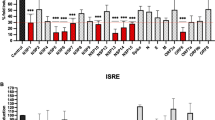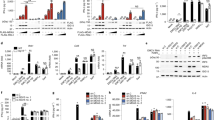Abstract
The molluscum contagiosum virus (MCV) uses a variety of immune evasion strategies to antagonize host immune responses. Two MCV proteins, MC159 and MC160, contain tandem death effector domains (DEDs). They are reported to inhibit innate immune signaling events such as NF-κB and IRF3 activation, and apoptosis. The RxDL motif of MC159 is required for inhibition of both apoptosis and NF-κB activation. However, the role of the conserved RxDL motif in the MC160 DEDs remained unknown. To answer this question, we performed alanine mutations to neutralize the arginine and aspartate residues present in the MC160 RxDL in both DED1 and DED2. These mutations were further modeled against the structure of the MC159 protein. Surprisingly, the RxDL motif was not required for MC160′s ability to inhibit MAVS-induced IFNβ activation. Further, unlike previous results with the MC159 protein, mutations within the RxDL motif of MC160 had no effect on the ability of MC160 to dampen TNF-α-induced NF-κB activation. Molecular modeling predictions revealed no overall changes to the structure in the MC160 protein when the amino acids of both RxDL motifs were mutated to alanine (DED1 = R67A D69A; DED2 = R160A D162A). Taken together, our results demonstrate that the RxDL motifs present in the MC160 DEDs are not required for known functions of the viral protein.








Similar content being viewed by others
References
C.M. Randall, J.L. Shisler, Future Virology 8, 561–573 (2013)
X. Chen, A.V. Anstey, J.J. Bugert, Lancet. Infect. Dis 13, 877–888 (2013)
J.L. Shisler, Adv. Virus Res. 92, 201–252 (2015)
T.G. Senkevich, J.J. Bugert, J.R. Sisler, E.V. Koonin, G. Darai, B. Moss, Science 273, 813–816 (1996)
T.G. Senkevich, E.V. Koonin, J.J. Bugert, G. Darai, B. Moss, Virology 233, 19–42 (1997)
L.E. Murao, J.L. Shisler, Virology 340, 255–264 (2005)
D.B. Nichols, J.L. Shisler, J. Virol. 80, 578–586 (2006)
D.B. Nichols, J.L. Shisler, J. Virol. 83, 3162–3174 (2009)
C. Randall, J. Shisler, Future Virol. 8, 561–573 (2013)
C.M. Randall, S. Biswas, C.V. Selen, J.L. Shisler, Proc. Natl. Acad. Sci. U.S.A. 111, E265–272 (2014)
C.M. Randall, J.A. Jokela, J.L. Shisler, J. Immunol. 188, 2371–2379 (2012)
J.L. Shisler, B. Moss, Virology 282, 14–25 (2001)
J. Bertin, R.C. Armstrong, S. Ottilie, D.A. Martin, Y. Wang, S. Banks, G.H. Wang, T.G. Senkevich, E.S. Alnemri, B. Moss, M.J. Lenardo, K.J. Tomaselli, J.I. Cohen, Proc. Natl. Acad. Sci. U.S.A. 94, 1172–1176 (1997)
S. Balachandran, T. Venkataraman, P.B. Fisher, G.N. Barber, J. Immunol. 178, 2429–2439 (2007)
R.B. Seth, L. Sun, C.K. Ea, Z.J. Chen, Cell 122, 669–682 (2005)
T. Kawai, K. Takahashi, S. Sato, C. Coban, H. Kumar, H. Kato, K.J. Ishii, O. Takeuchi, S. Akira, Nat. Immunol. 6, 981–988 (2005)
M. Yoneyama, M. Kikuchi, T. Natsukawa, N. Shinobu, T. Imaizumi, M. Miyagishi, K. Taira, S. Akira, T. Fujita, Nat. Immunol. 5, 730–737 (2004)
V. Hornung, J. Ellegast, S. Kim, K. Brzozka, A. Jung, H. Kato, H. Poeck, S. Akira, K.K. Conzelmann, M. Schlee, S. Endres, G. Hartmann, Science 314, 994–997 (2006)
A. Pichlmair, O. Schulz, C.P. Tan, T.I. Naslund, P. Liljestrom, F. Weber, C. Reis e Sousa, Science 314, 997–1001 (2006)
H. Kato, O. Takeuchi, S. Sato, M. Yoneyama, M. Yamamoto, K. Matsui, S. Uematsu, A. Jung, T. Kawai, K.J. Ishii, O. Yamaguchi, K. Otsu, T. Tsujimura, C.S. Koh, C. Reis e Sousa, Y. Matsuura, T. Fujita, S. Akira, Nature 441, 101–105 (2006)
K.A. Fitzgerald, S.M. McWhirter, K.L. Faia, D.C. Rowe, E. Latz, D.T. Golenbock, A.J. Coyle, S.M. Liao, T. Maniatis, Nat. Immunol. 4, 491–496 (2003)
S. Sharma, B.R. tenOever, N. Grandvaux, G.P. Zhou, R. Lin, J. Hiscott, Science 300, 1148–1151 (2003)
G. Oganesyan, S.K. Saha, B. Guo, J.Q. He, A. Shahangian, B. Zarnegar, A. Perry, G. Cheng, Nature 439, 208–211 (2006)
J.K. Yang, L. Wang, L. Zheng, F. Wan, M. Ahmed, M.J. Lenardo, H. Wu, Mol. Cell 20, 939–949 (2005)
F.Y. Li, P.D. Jeffrey, J.W. Yu, Y. Shi, J. Biol. Chem. 281, 2960–2968 (2006)
P.E. Carrington, C. Sandu, Y. Wei, J.M. Hill, G. Morisawa, T. Huang, E. Gavathiotis, M.H. Werner, Mol. Cell 22, 599–610 (2006)
C. Shen, H. Yue, J. Pei, X. Guo, T. Wang, J.M. Quan, Biochem. Biophys. Res. Commun. 463, 297–302 (2015)
T.L. Garvey, J. Bertin, R.M. Siegel, G.H. Wang, M.J. Lenardo, J.I. Cohen, J. Virol. 76, 697–706 (2002)
2016-4 S.R. Epik; Impact; and Prime (Schrodinger LLC, New York, 2016)
2016-4 S.R. Prime (Schrodinger, LLC. New York, 2016)
S. Kreuz, D. Siegmund, J.J. Rumpf, D. Samel, M. Leverkus, O. Janssen, G. Hacker, O. Dittrich-Breiholz, M. Kracht, P. Scheurich, H. Wajant, J. Cell Biol. 166, 369–380 (2004)
H. Su, N. Bidere, L. Zheng, A. Cubre, K. Sakai, J. Dale, L. Salmena, R. Hakem, S. Straus, M. Lenardo, Science 307, 1465–1468 (2005)
A. Oberst, D.R. Green, Nat. Rev. Mol. Cell Biol. 12, 757–763 (2011)
M. Sato, H. Suemori, N. Hata, M. Asagiri, K. Ogasawara, K. Nakao, T. Nakaya, M. Katsuki, S. Noguchi, N. Tanaka, T. Taniguchi, Immunity 13, 539–548 (2000)
A.S. Yang, B. Honig, J. Mol. Biol. 301, 665–678 (2000)
Acknowledgements
We would like to thank Joanna Shisler. This work was funded by Seton Hall University and the Seton Hall University Research Council. Structure coordinates of the homology model of MC160 are available upon request.
Author information
Authors and Affiliations
Contributions
Author contributions
MB, UKV, SW, CS, TTT, and DBN have made substantial contributions to work described herein.
Corresponding author
Ethics declarations
Conflicts of interest
The authors have no conflicts of interest to declare.
Ethical approval
The research described in the paper does not use any human or animal subjects.
Additional information
Edited by Wolfram Gerlich.
Electronic supplementary material
Below is the link to the electronic supplementary material.
Rights and permissions
About this article
Cite this article
Beaury, M., Velagapudi, U.K., Weber, S. et al. The molluscum contagiosum virus death effector domain containing protein MC160 RxDL motifs are not required for its known viral immune evasion functions. Virus Genes 53, 522–531 (2017). https://doi.org/10.1007/s11262-017-1456-9
Received:
Accepted:
Published:
Issue Date:
DOI: https://doi.org/10.1007/s11262-017-1456-9




